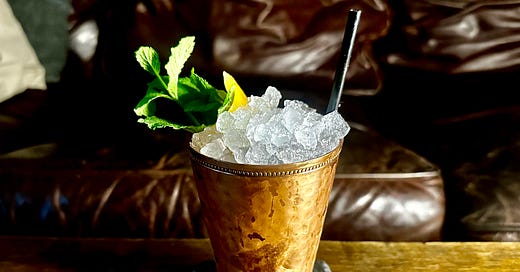Yes, Even a Mint Julep Can Be Made With Cynar
For Derby Week, two ways to make an unusual, bittersweet julep.
As we approach this year’s Kentucky Derby, we return again to the race’s signature cocktail, the Mint Julep.
A sad fact about the Mint Julep is that even in Kentucky, most versions of the drink will not be very well made. They will be under or over-diluted, too minty or not minty enough, too harsh or too mellow.
This has been true for decades. As cocktail journalist William Grimes wrote in The New York Times all the way back in 1997, “about 100,000 juleps will be consumed at Churchill Downs during Derby Week.” And yet, he lamented, “they will not be very good.”
Grimes went on to describe how, even amongst Southerners, the drink was not widely consumed, with a large majority reporting never drinking one.
I don’t have any updated statistics, but if I had to guess, the number of julep imbibers has crept up somewhat in the ensuing decades, as the Derby has become even more of a scene and its various particulars — the hats, the seersucker, the whiskey, and so forth — have become something more than just regional artifacts.
It’s certainly possible to find high-quality juleps these days, as craft bartenders have taken up the challenge. But even still, the majority of those made this week will probably be mediocre at best — consumed more as ritual signifiers of the Derby aesthetic rather than as drinks to be enjoyed on their own merits.
This probably explains why it took me so long to come around on the drink. For a long time, I thought it might be the rare classic cocktail that I couldn’t find a way to enjoy. Eventually, however, I found a way in. And last year I published a recipe that I stand by for anyone who just wants a classic bourbon-based Mint Julep.
In workshopping that drink, I had to develop a conceptual underpinning for what made it work and what the fundamental appeal was — a practical theory, if you will, of the Mint Julep.
That theory, in turn, helped me explore and understand other cocktails in the Mint Julep extended family — and to see the drink as a template rather than as a single, specific recipe for a drink.
Perhaps not surprisingly, it wasn’t too long before I stumbled on this week’s cocktail, the Cynar Julep — which is, well, more or less what it sounds like: a Mint Julep made with Cynar instead of whiskey.
Once more, with feeling: I really do put Cynar in everything.
But most Cynar Julep recipes typically don’t call for a straight 1:1 Cynar-for-whiskey swap relative to their whiskey-based counterparts. Most versions also contain grapefruit juice, club soda, and, in some iterations, a few other ingredients as well. It’s a lighter, longer, lower-proof drink — almost more akin to an Americano or some other bittered highball than a classic whiskey-forward Mint Julep. It’s also delicious, and especially appealing to a Cynar diehard like me.
So for this Derby Week edition of the newsletter, we are going to look at the core elements of the julep category. And then we are going to look at two different ways to make a julep with Cynar: First, the juicy, light, highball-esque version I described above, and second, a simplified, stripped-down, easier-to-make version that, in my opinion, more precisely captures the sense of what a drink called a Cynar Julep should be.
What Makes a Julep a Julep?
At this point, I own dozens and dozens of cocktail books.1 And many of those books have entries on the Mint Julep, typically offering a recipe and perhaps a bit of history. 2
But despite the enthusiasm cocktail aficionados have often displayed for categorization, almost none of them have sections treating the julep as a category — as a type of drink, a format, a blueprint. A rare exception is The New York Times Essential Book of Cocktails, which collects a couple of the paper’s essays on the julep as well as an assortment of recipes.
Scanning through the book’s julep recipes gives you a sense of what connects different renditions of the drink. Most, unsurprisingly, are relatively straightforward drinks made with bourbon and specific attention to various details, such as whether or not to use simple syrup or sugar in the drink.
But there are a number of less-common iterations as well. For example, there’s the Prescription Julep, a version offered up by cocktail historian David Wondrich, based on an 1857 recipe published in Harper’s, that relies on cognac, as well as a version by Dale DeGroff, one of modern cocktaildom’s grand eminences, that adds a bit of apry, or apricot, liqueur — which, in his book The Essential Cocktail, he explains was intended to give the drink a bit more complexity.
Other entries, however, go even further afield: There’s a gin julep, a rum julep, and even a drink called the Fort Julep, developed by newsletter favorite Joaquín Simó, built out of Lillet Rose and green Chartreuse.
What connects all of these drinks? What makes them all juleps?



